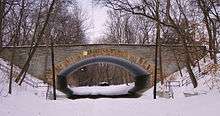Interlachen Bridge
| Interlachen Bridge | |
|---|---|
 | |
| Coordinates | 44°55′53″N 93°18′31″W / 44.93139°N 93.30861°WCoordinates: 44°55′53″N 93°18′31″W / 44.93139°N 93.30861°W |
| Carries | Two lanes of William Berry Parkway |
| Crosses | The Como-Harriet Streetcar Line a former Twin City Rapid Transit streetcar line now operated by the Minnesota Streetcar Museum |
| Locale | Minneapolis, Minnesota |
| Maintained by | Minneapolis Park Board |
| Characteristics | |
| Design | Concrete arch using the Melan reinforcement system[1] |
| Total length | 40 feet |
| Width | 63 feet |
| Longest span | 38.6 feet |
| Clearance below | 16 feet |
| History | |
| Opened | 1900 |
The Interlachen Bridge is a reinforced concrete arch bridge on William Berry Parkway between Lake Calhoun and Lake Harriet in Minneapolis, Minnesota. The bridge crosses the Como-Harriet Streetcar Line, a heritage streetcar line operated by the Minnesota Streetcar Museum which follows the same right-of-way as the original Twin Cities Rapid Transit line of the same name. The bridge was designed by local builder William S. Hewett. The bridge is one of the most significant bridges in Minnesota because it is the earliest known extant concrete bridge with a documented construction date.[2] The bridge was listed on the National Register of Historic Places on November 6, 1989, as part of the Reinforced-Concrete Highway Bridges in Minnesota MPS.[3]
The Interlachen Bridge was based on the Melan reinforcing system, invented by Viennese engineer Josef Melan and patented in the United States in 1894.
References
- ↑ "Interlachen Bridge - Description". Minnesota Historical Society. 1996. Retrieved 2008-03-12.
- ↑ "Interlachen Bridge - Historic Significance". Minnesota Historical Society. 1996. Retrieved 2008-03-12.
- ↑ National Park Service (2007-01-23). "National Register Information System". National Register of Historic Places. National Park Service.